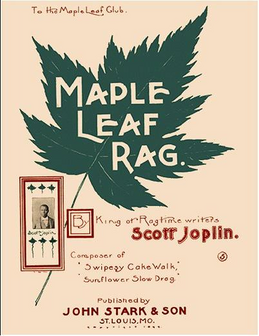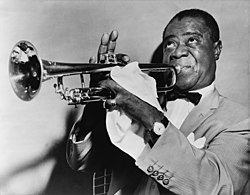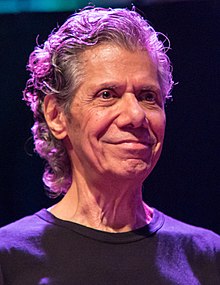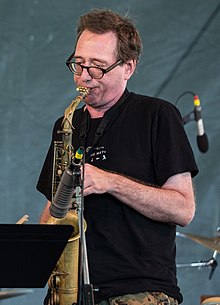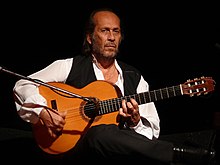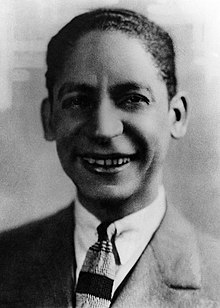Portal:Jazz
Welcome to the jazz portal

Jazz is a music genre that originated in the African-American communities of New Orleans, Louisiana, in the late 19th and early 20th centuries, with its roots in blues, ragtime, European harmony and African rhythmic rituals. Since the 1920s Jazz Age, it has been recognized as a major form of musical expression in traditional and popular music. Jazz is characterized by swing and blue notes, complex chords, call and response vocals, polyrhythms and improvisation.
As jazz spread around the world, it drew on national, regional, and local musical cultures, which gave rise to different styles. New Orleans jazz began in the early 1910s, combining earlier brass band marches, French quadrilles, biguine, ragtime and blues with collective polyphonic improvisation. However, jazz did not begin as a single musical tradition in New Orleans or elsewhere. In the 1930s, arranged dance-oriented swing big bands, Kansas City jazz (a hard-swinging, bluesy, improvisational style), and gypsy jazz (a style that emphasized musette waltzes) were the prominent styles. Bebop emerged in the 1940s, shifting jazz from danceable popular music toward a more challenging "musician's music" which was played at faster tempos and used more chord-based improvisation. Cool jazz developed near the end of the 1940s, introducing calmer, smoother sounds and long, linear melodic lines.
The mid-1950s saw the emergence of hard bop, which introduced influences from rhythm and blues, gospel, and blues to small groups and particularly to saxophone and piano. Modal jazz developed in the late 1950s, using the mode, or musical scale, as the basis of musical structure and improvisation, as did free jazz, which explored playing without regular meter, beat and formal structures. Jazz-rock fusion appeared in the late 1960s and early 1970s, combining jazz improvisation with rock music's rhythms, electric instruments, and highly amplified stage sound. In the early 1980s, a commercial form of jazz fusion called smooth jazz became successful, garnering significant radio airplay. Other styles and genres abound in the 21st century, such as Latin and Afro-Cuban jazz. (Full article...)
Selected articles -
Selected image
Related portals
Selected biographies -
Did you know (auto-generated)

- ... that the jazz collective West Coast Get Down once recorded around 190 songs over the course of a month?
- ... that Wanda Warska was nicknamed the "First Lady of Polish Jazz"?
- ... that jazz saxophonist Chris Byars ended his childhood operatic career when his voice croaked during a performance?
- ... that in 2021 Sarah Aristidou recorded Jörg Widmann's Labyrinth V, a wordless piece for her soprano voice with "ululations, sobs, jazz inflections and wild laughter"?
- ... that Tim Kinsella made most of the lyrics for Cap'n Jazz's only album, Shmap'n Shmazz, during his first experience with psilocybin mushrooms?
- ... that an attempt to jazz up a South Carolina radio station did not get much response from listeners?
More did you know...


• ... that John McLaughlin's Grammy nominated album To the One was inspired by John Coltrane's album A Love Supreme?
• ... that Stanley Clarke's album The Stanley Clarke Band won the 2011 Grammy Award for Best Contemporary Jazz Album?
• ... that the Grammy-nominated album Now Is the Time features the Blood, Sweat & Tears horn section on two of its tracks?
• ... that James Moody (pictured, left) received his first Grammy Award for Moody 4B after he died?
• ... that Joey DeFrancesco's tribute to Michael Jackson, Never Can Say Goodbye: The Music of Michael Jackson, was nominated for a Grammy Award?
• ... that Lenny Kravitz was a guest musician on Backatown, the major label debut by his former apprentice Trombone Shorty (pictured, right)?
March 2011
Selected recording
"At the Jazz Band Ball", played by the Dixieland Jazz Band ensemble of the U.S. Coast Guard Band for the album "U.S. Coast Guard Bicentennial, 1790–1990".
Jazz by topic
Quality content
Categories
Things you can do

Create an article on a jazz-related subject
Suggest new selected articles and images for the portal here
Add new selected articles here
Add new selected biographies here
Add new selected images here
The Jazz WikiProject

The Jazz WikiProject works to improve the quality of jazz-related articles on Wikipedia. Please join us!
Associated Wikimedia
The following Wikimedia Foundation sister projects provide more on this subject:
-
Commons
Free media repository -
Wikibooks
Free textbooks and manuals -
Wikidata
Free knowledge base -
Wikinews
Free-content news -
Wikiquote
Collection of quotations -
Wikisource
Free-content library -
Wikiversity
Free learning tools -
Wiktionary
Dictionary and thesaurus


